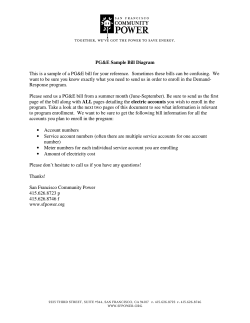
ELECTRICITY REGULATORY AUTHORITY
ELECTRICITY REGULATORY AUTHORITY Plot 15 Shimoni Road, Nakasero P.O. Box 10332, Kampala Tel: 041-4341852/646, Fax 041-4341624, info@era.or.ug www.era.or.ug Press Statement for Quarter 4, 2014 ERA House, Kampala – October 21, 2014 at 10:00am Ladies and Gentlemen, Electricity Regulatory Authority is pleased to share with you the developments that have taken place in the electricity industry since the beginning of 2014 up until September 2014, and to give you an insight of the future outlook. 1. Electricity Demand and Supply Currently, Uganda is enjoying more stable electricity supply which is provided from large and mini hydropower resources as well as cogeneration plants. There has been no load shedding since the year started. The existing supply from renewable energy sources is sufficient to meet the current demand. The maximum peak demand has been relatively stable between January 2014 and August 2014, at a monthly average of 491MW. The average shoulder demand was 434MW while the off peak demand was 346MW. We presently have reserve capacity of 100MW from two heavy fuel oilbased plants, one in Tororo and the other in Namanve. These plants have been minimally dispatched since the beginning of 2014 in fulfilment of contractual obligations. 1|Page 2. Plans to Expand Generation Capacity With the growing demand for electricity, estimated between 10-12% per annum in the short to medium term, Electricity Regulatory Authority (ERA) will continue to focus the regulatory thrust on expansion of generation capacity, with corresponding investment in transmission and distribution infrastructure. A number of programmes and projects are currently being implemented to ensure adequate supply capacity. These include:a) Small Renewable Energy Projects ERA, working with other Government Agencies and Development Partners, established the Global Energy Transfer for Feed–in–Tariffs (GET-FiT), an initiative to accelerate renewable energy development including hydropower, solar, wind and biomass technologies. This initiative provides a top-up premium in the range of 0.5-2.0 US cents per kilowatt hour on the Renewable Energy Feed-in-Tariff (REFIT). It also avails a guarantee scheme to enhance the bankability of the projects. The GET-FiT Programme has advanced and two evaluation rounds have been conducted, one in 2013 and the second in March 2014. A total capacity of 108.5MW was approved during the first and second rounds of bidding as shown in Table 1. The approved projects to date represent a commitment of EUR 70million in GET-FiT premiums. Construction of these projects will commence before the end of 2014 and will be brought into production within the next two to three years. 2|Page Table 1: Approved GET-FiT Projects Project Name Nyamwamba Rwimi Kikagati Kakira Siti 1 Siti 2 Waki Nengo Bridge PH Industrial Farms Lubilia Kawembe Hydro Muvumbe Hydro Uganda Limited Sugar and Allied Industries Total Installed Capacity (MW) 9.2 5.5 16.0 20.0 5.0 16.5 4.8 6.7 1.0 5.4 6.5 11.9 108.5 With additional funding from the European Union, the programme has expanded to solar photovoltaic (pv), targeting to bring on stream up to 50MW. The bidding process for the first 20MW is in advanced stages. The GET-FiT initiative is aimed at bridging the generation gap likely to occur between 2015 and 2018 before commissioning of the next large hydropower plants. In order to accelerate the licensing process and facilitate faster conclusion of negotiations with the Transmission Company and Government of Uganda, ERA developed standardized Power Purchase Agreements, Implementation Agreements and model Licenses for small hydropower and bagasse co-generation technologies. b) Large Hydropower Development Government of Uganda (GOU) is committed to undertake large hydropower development under Public Private Partnership financing arrangement. The construction of the 600MW Karuma hydropower plant is underway; with expected completion in 2018/19. Construction of the 183MW Isimba hydropower project also 3|Page commenced in 2014; the project is expected to be commissioned in 2016/17. Government will continue to develop other large hydropower projects such as Ayago and Oriang along the River Nile, as well as small non-Nile hydropower projects such as Muzizi and Nyagak III. 3. Licensing of Electricity Projects 3.1. Licenses and Permit Issued Licensing constitutes one of the major output areas for ERA. Various license and permit applications for generation, transmission, distribution and sale of electricity were received, reviewed and issued during the period January – September 2014. The Authority issued nine (09) Licenses for construction of renewable energy projects with a total installed capacity of 132.7MW, namely:i) 5MW Siti 1 hydropower plant; ii) 16.5MW Siti 2 hydropower plant; iii) 5.54MW Rwimi hydropower plant; iv) 5.0MW Kakaka hydropower plant; v) 5.4MW Lubilia hydropower plant; vi) 1.0MW biomass gasification plant; vii) 4.8MW Waki hydropower plant; viii) 6.5MW Muvumbe hydropower plant; and, ix) 83MW Achwa hydropower plant. Two (02) License Exemptions were issued to Bwindi Community Micro Hydro Project Limited and Pamoja Energy Limited for establishment of 64kW hydropower and 43kW biomass projects in Bwindi and Muduma respectively. The Authority issued fifteen (15) Permits to enable Companies to undertake detailed feasibility studies for various projects, details of which are presented in Table 2. 4|Page Table 2 Feasibility Study Permits issued from January – September 2014 SN Project Name Location 1 Kabarole 9 Nsongya hydropower project Tororo solar project Bukwa hydropower project Nyamagasani 2 hydropower project Lower Nkusi hydropower project Atari hydropower project Bagasse cogeneration project Kanyampara hydropower project Natural gas project 10 2 3 Installed Capacity, MW 9.2 Developer Savimaxx Limited Tororo Bukwo 10 9 CIRE Uganda Limited C&G Andijes Limited Kasese 8 Kibaale 11 Nyamaghasani 2 Hydropower Plant Limited Schima Group Limited Kapchorwa 8 Mayuge 21 Kasese 1.6 Hoima 50 Nyakabale Rukungiri 0.4 11 Nyahuka Bundibugyo 0.5 12 Hoima Hoima 13 Nchwera Mitooma 0.5 14 Nsongya Kabarole 0.5 15 Warugo Bushenyi 0.73 4 5 6 7 8 1.958 Ngoryomwo Small Hydro Limited Mayuge Sugar Industries Limited Marma Technical Services Limited and Kol Services Limited Lake Albert Infrastructure Services Uganda Energy Credit Capitalization Company Limited Uganda Energy Credit Capitalization Company Limited Uganda Energy Credit Capitalization Company Limited Uganda Energy Credit Capitalization Company Limited Uganda Energy Credit Capitalization Company Limited Uganda Energy Credit Capitalization Company Limited If the detailed studies confirm technical, financial and economic viability of these projects, an extra 132MW capacity will be added onto the existing generation. The Authority discourages speculative behaviour in this sector among applicants for Licenses and Permits. Such behaviour impedes the development of the electricity sector despite the favorable policy framework in place and an attractive tariff regime. 5|Page 3.2. Installation Permits Issued Under provisions of Section 88 of the Electricity Act 1999 and Regulation 5 of the Electricity (Installation Permits) Regulations Statutory Instrument No 19 of 2003, the Authority licenses persons and companies qualified to install electrical wiring or extensions to existing wiring on premises within Uganda. In fulfilment of this mandate, the Authority issues Installation Permits and monitors the performance of ERA-certified wiremen and contractors. ERA received a total of 300 new applications for Installation Permits for the period January - September 2014, out of which 249 qualified and were issued Permits. The Authority periodically publishes a list of certified wiremen who are authorized to carry out electrical installation works. The same list is available on our website www.era.or.ug. We call upon the public to always engage ERA-certified wiremen to wire their premises. We would like to inform the public that in an effort to create awareness of this legal requirement and knowledge of certified wiremen, the Authority undertakes regional sensitization drives throughout the Country on a regular basis. Activities undertaken include radio talk shows and free training for Technicians. The activity plan for the Installation Permits Committee is readily available on our website www.era.or.ug. 4. Energy Efficiency and Demand Side Management The Authority recognizes that consumer demand for energy can be managed to improve distribution efficiency hence the need for Demand Side Management (DSM) efforts. To this effect, we are collaborating with other institutions (MEMD, Utilities, etc) to strengthen regulatory initiatives to support Energy Efficiency practices and Demand Side Management (DSM). We developed a Demand Side Management Plan with the aim of increasing focus on energy efficiency initiatives and development and implementation of demand side management measures. These are important in management of the peak demand to defer the need for additional generation capacity. 6|Page To that effect, the Authority has allocated US $ 4.1million towards this initiative which, among others, includes procurement and distribution of light emitting diodes (LEDs) to replace the high energy consuming incandescent bulbs that are currently in use by domestic consumers. The initial batch of 420,000 LEDs will be distributed to consumers starting January 2015. The Authority has also adjusted the peak weighting used in tariff calculation to encourage consumers to shift consumption from peak time periods (evenings) to off-peak and shoulder time periods (day time and late night). We are also sensitizing consumers about efficient energy use through, among others, dissemination of information booklets titled ‘How To Reduce Your Electricity Bill’. Going forward, ERA will continue coordinating with distribution utilities and other stakeholders to implement comprehensive demand side management and energy efficiency measures. The benefits that will accrue from implementation of these measures include: Energy cost savings to the domestic consumer; Energy costs and demand cost savings to the industrial consumer; and, Less constraint on the utility network. These initiatives will go a long way in addressing the electricity supplydemand gap that is apparent in the short to medium term. 5. Compliance Monitoring and Enforcement The ERA is mandated to enforce compliance of Licensees with obligations in their Licenses, the Electricity Act and Regulations thereto. During the period January – September 2014, the Authority carried out statutory inspections of operations of ten Licensees. Generation companies inspected include Kinyara, Mpanga, Nyagak 1, Bujagali, Sugar Corporation of Uganda Limited, Kakira Sugar Limited and Electromaxx Uganda Limited. Distribution companies inspected include Umeme 7|Page Limited, West Nile Rural Electrification Company (WENRECo) Limited and Uganda Electricity Distribution Company Limited. Most of the entities inspected were found to be largely compliant, except for a few areas where the Companies committed to undertake corrective measures within a specified period of time. During this period, ERA conducted a compliance workshop for Licensees where various stakeholders were brought on board to share their experiences as well as agree on addressing the challenges in the electricity sector. 6. Electricity Prices and Financial Performance of the Sector The Authority approved and gazetted the Quarterly Tariff Review Methodology which was implemented effective January 2014. The Quarterly Tariff Review methodology provides for adjustment of the electricity tariffs for changes in the following:a) Inflation rate leading to Inflation Rate Adjustment Factor (IRAF); b) Exchange rate leading to Exchange Rate Adjustment Factor (FERFAF); and, c) Fuel prices on the World Market leading to Fuel Price Adjustment Factor (FPAF). The approved quarterly tariff review methodology provides for a capping mechanism where the retail tariff is not expected to increase by more than 2.5 percent per quarter as a result of implementation of the adjustment factors. In accordance with this methodology, the Authority has been releasing tariffs applicable for each quarter. The approved new end-user tariffs for the fourth quarter (October – December 2014) are shown in Table 3:- 8|Page Table 3: Quarter 4 2014 Adjustment Factors and Total Retail Tariff End-User Retail Electricity Tariffs (Shs/kWh) 2014 Base Tariff Domestic Commercial Medium Industrial 520.6 474.4 452.0 Large Industrial Streetlights Weighted Adjustment Factor 310.4 488.8 411.1 Tariff Adjustment Factors (Shs/kWh) Inflation Adjustment Factor(IRAF) Exchange Rate Adjustment Factor (FERFAF) Fuel Adjustment Factor (FPAF) Total Adjustment Factor 0.9 0.9 0.9 0.9 0.9 0.9 9.1 9.1 9.1 9.1 9.1 9.1 (11.9) (11.9) (11.9) (11.9) (11.9) (11.9) (1.9) (1.9) (1.9) (1.9) (1.9) (1.9) Resultant Retail Tariff 518.7 472.5 450.1 308.5 486.9 409.2 Percentage Change -0.36% -0.39% -0.41% -0.60% -0.38% -0.45% The Authority also considered various tariff applications and approved new end-user tariffs for Kilembe Investments Limited, Ferdsult Engineering Services Limited, Bundibugyo Energy Co-operative Society Limited, West Nile Rural Electrification Company Limited, Pader-Abim Community Multipurpose Electric Cooperative Society and Kyegegwa Rural Electricity Cooperative Society. The approved tariff schedules for these companies are readily available on our website www.era.or.ug. 7. Improving the Efficiency of the Electricity Industry There is continuous effort towards increasing efficiency of electricity generation, transmission and distribution. On the generation side, the Authority developed and continues to maintain a dynamic least cost generation planning framework with the objective of ensuring that cheaper sources of generation are exploited first. On the transmission side, the Authority has adopted the Multi-Year Tariff regime for Uganda Electricity Transmission Company Limited in order to create incentives for improving efficiency. The loss targets set for the company are shown in Table 4:- 9|Page Table 4: Transmission Loss Targets 2014 Power loss (%) 4.7 Energy loss (%) 3.8 2015 4.4 3.6 2016 4.0 3.3 Uganda Electricity Transmission Company Limited recently completed the refurbishment of the Mutundwe–Kabulasoke western axis line, which is expected to improve supply reliability to the Western part of the country. Other transmission projects under construction include the Mbarara-Nkenda 132Kv line, Tororo-Opuyo-Lira 132kV line and KawandaMasaka 220kV line. Two regional interconnection projects are also under construction, namely, the Uganda-Kenya and Uganda-Rwanda 220kV line. On the distribution side, Umeme Limited has continued to roll out prepayment with 41,495 customers connected between January and June 2014, bringing the total number of customers connected on the prepayment system to 94,229. The Authority is finalizing guidelines to govern pre-payment metering for all licensed distribution utilities. These guidelines will be completed and published before the end of this year. Umeme Limited has continued to register good progress in as far as reducing distribution losses is concerned. For the period January to June 2014, the Company reported distribution losses of 21.3% compared to the loss level of 23.4% as at December 2013. Distribution collection rates were reported at an average of 96% for the period January to June 2014, compared to an annual average of 95.8% in 2013. The Authority will continue to monitor the performance of this Company in line with the seven- year performance targets that were set in 2012. 10 | P a g e 8. Handling of Consumer Complaints The Electricity Regulatory Authority, in October 2012, set up a Consumer Affairs Unit with a duty to handle consumer related issues and complaints. The Consumer Affairs Unit is responsible for all electricity consumer complaints received at ERA, and ensures that all complaints are handled by Licensees within the existing regulations. The public is encouraged to call our dedicated complaints telephone line +256 757 341647 to register electricity supply-related complaints. The Authority is also in advanced stages of establishing a Contact Centre to enable us serve the public better. As an overseer of the electricity sector, we shall continue to focus on provision of safe, efficient, reliable and sustainable electricity supply. I thank you all for coming; we can now take some questions. ___________________ Benon M. Mutambi, PhD Chief Executive Officer 11 | P a g e
© Copyright 2025



















